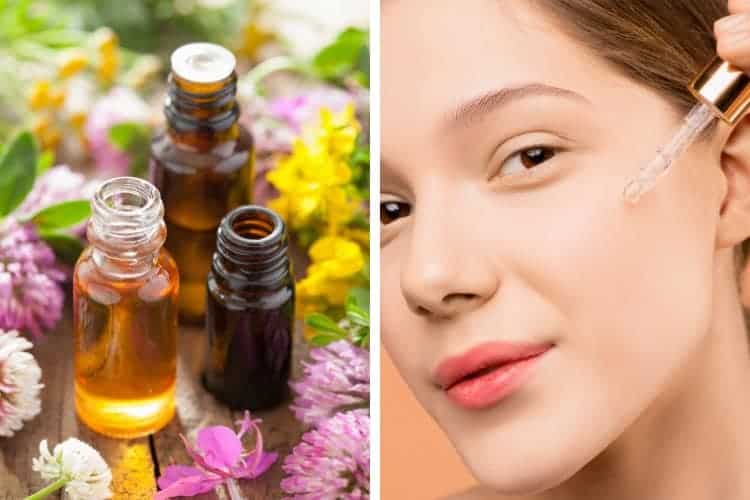
Skin-friendly essential oils like tea tree, lavender and frankincense can work wonders on our skin…as long as we dilute them properly. In fact, dilution can totally make or break your experience with oils. So, that’s why this article is going to walk you through how to dilute essential oils for skin correctly.
We’re going to look at:
- why dilution is a must.
- the best carrier oils for diluting essential oils.
- essential oils that are safe for the face and body.
NOTE: the dilution recommendations in this article come from the Tisserand Institute (1, 2) and the National Association for Holistic Aromatherapy.
WHY ESSENTIAL OIL DILUTION IS NECESSARY FOR TOPICAL APPLICATION
Have you ever heard of “neat” application? It basically refers to applying undiluted essential oils directly to the skin.
Neat application is often done with oils like lavender, tea tree and rose. These oils are skin-friendly, and in many cases there are no visible adverse reactions from using them undiluted.
However, unless you’re dealing with a serious and acute situation (such as an open wound) neat application isn’t the best way to apply essential oils on a daily basis.
To get the most skin care or beauty benefits, it’s actually better to dilute your essential oils.
Dilution offers 3 key benefits that you should take into consideration. Here they are:
1. Dilution Enhances Absorption
Undiluted essential oils start to evaporate quite quickly when they’re exposed to the air.
So, let’s say you apply lavender over an old scar that you’re trying to fade (this is a popular use of lavender!).
A portion of that oil will disappear before it’s had a chance to be absorbed into your skin.
On the other hand, when you dilute the essential oil with the right carrier (we’ll talk about carriers soon!) the essential oil is dispersed within the carrier.
Therefore, when you apply the carrier onto your skin the essential oils have time to be absorbed without worry of evaporation.
2. Dilution Protects The Skin From Dryness
Generally speaking, essential oils can be quite drying.
So, if you make it a habit of applying them undiluted, your skin can start to dry out.
This is why it’s so important to blend your essential oil with a nourishing carrier agent. It’s the best way to enjoy the healing properties of the essential oil while also nourishing your skin.
3. Diluting Essential Oils Means Less Risk of Irritation and Toxicity
Even when using “safe” essential oils like lavender, it’s still possible to have a bad reaction to them when they’re undiluted.
In such a situation, you might get blisters, redness, itching and/or a burning sensation (source):
So, once again, using a carrier comes in very handy.
Furthermore, regular use of undiluted essential oils puts a strain on your liver and nervous system.
So, when it’s all said and done, it’s always best to dilute all essential oils.
NOTE: since there are 8 billion of us on this planet, there will always be exceptions to every rule! So, don’t be surprised if you still experience an adverse reaction to an oil, even in the diluted form. It’s a sign that you’re sensitive to that oil and you should either reduce the dilution ratio, or avoid it completely.
CARRIER OILS TO MIX WITH ESSENTIAL OILS
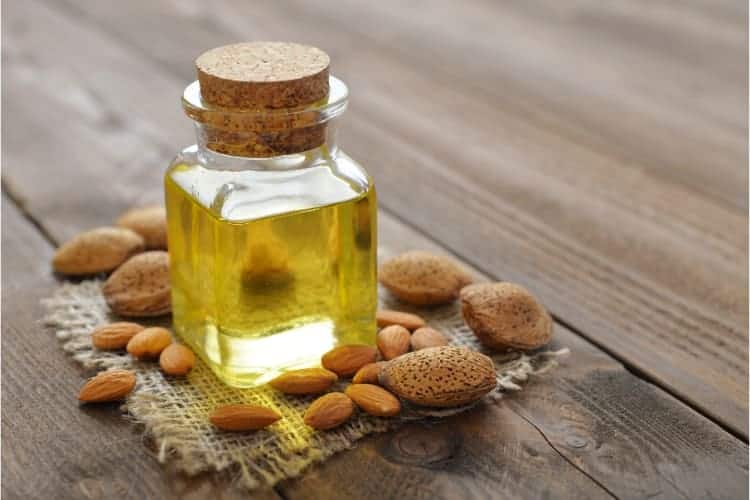
Essential oils are mainly lipophilic, which means that they dissolve in fats. As a result, the best way to dilute essential oil is to mix them with carrier oils.
The carrier oil serves as the medium in which the essential oil dissolves so that it can be “carried” to (and through) the skin safely.
Now, as for which carrier oils to use, the best ones are those that are liquid at room temperature (about 76 degrees fahrenheit).
In addition to using a liquid oil, it’s also important to choose an oil that matches your skin profile i.e. dry, normal, combination, sensitive, oily or acne-prone.
Based on all of the above, here are some carrier oils that are ideal for diluting essential oils.
| CARRIER OIL | SKIN TYPE |
|---|---|
| Almond oil | all skin types |
| Apricot kernel oil | all skin types |
| Argan oil | all skin types |
| Avocado oil | all skin types |
| Coconut oil (regular and fractionated) | dry, parched skin, mature skin. Can clog pores for some people, especially if you have oily/acne-prone skin. |
| Hazelnut oil | all skin types |
| Grapeseed oil | all skin types |
| Hemp seed oil | dry skin; mature skin; combination skin |
| Jojoba oil | all skin types |
| Macadamia nut oil | all skin types |
| Olive oil | all skin types |
| Pomegranate seed oil | all skin types |
| Rosehip oil | all skin types |
| Sesame oil | dry skin; combination skin, mature skin |
| Safflower oil | all skin types |
| Sunflower oil | all skin types |
| Walnut oil | all skin types |
NOTE: you can also dilute essential oils in thick oils (like castor oil) or butters (such as shea butter). However, because these are all very heavy, you won’t absorb quite as much of the essential oil as you would with a lighter oil. Also, be aware that mineral oil is not a suitable carrier for essential oils since it places a heavy barrier on the skin. This barrier can prevent essential oil absorption.
HOW TO DILUTE ESSENTIAL OILS FOR SKIN: DILUTION CHART
The general guidelines for applying essential oils on the skin are as follows:
- Face products: 0.2 to 1.5% dilution.
- Massage oil: 1.5 – 3% dilution.
- Bath products (such as bath bombs) or body care products (such as moisturizer): 1 – 4%
- Pain and wounds: 5 – 20%
Do keep in mind that there are some exceptions to the above: For example:
- each essential oil has its own individual recommended dilution ratio for topical application (which can differ from the general guidelines provided above).
- because the face is so sensitive, it’s always best to stick to a max dilution of 1.5% for daily cosmetics (regardless of the recommended dilution of a specific oil). The rest of the body can usually handle higher dilutions.
- for special skin issues on the face, you may need to temporarily use a higher dilution. For example, it’s quite common to use a 5% or higher dilution of tea tree oil for acne.
Here’s an essential oil dilution chart that you can use for face application (source):
| 15ml (1/2 oz, 1 Tbsp) | 30ml (1 oz, 2 Tbsp) | 60ml (2 oz, 3 Tbsp) | |
| .2% | 1 drop | 2 drops | 4 drops |
| .5% | 2 drops | 4 drops | 9 drops |
| 1% | 4 drops | 9 drops | 18 drops |
| 1.5% | 6 drops | 13 drops | 27 drops |
| 2% | 9 drops | 18 drops | 36 drops |
| 3% | 13 drops | 27 drops | 45 drops |
| 4% | 18 drops | 36 drops | 72 drops |
| 5% | 22 drops | 45 drops | 90 drops |
| 10% | 44 drops | 90 drops | 180 drops |
ESSENTIAL OILS THAT ARE GOOD FOR THE SKIN: LAVENDER, LEMON AND MORE
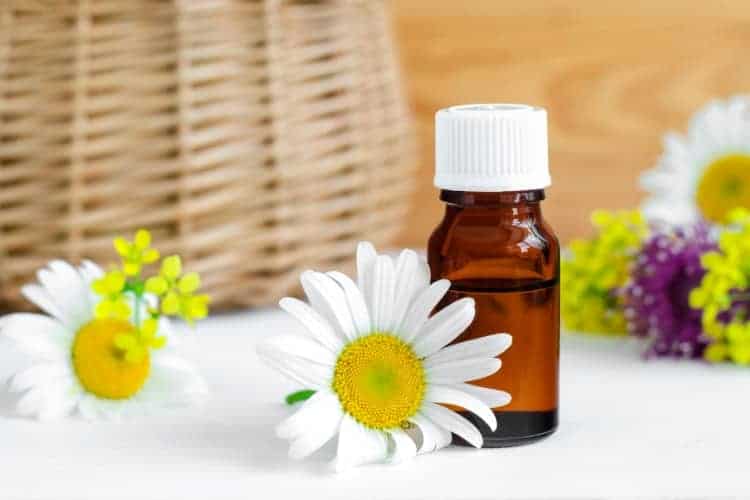
There are several dozens of essential oils that can be used on the skin. In this section we’re going to look at just a few of them and their benefits.
1. Bergamot
- Antibacterial and anti-inflammatory, can help with painful cystic acne.
- Skin types: oily and acne prone skin.
- Recommended dilution: 2-5%.
2. Carrot Seed
- Antibacterial and anti-inflammatory.
- Rich in antioxidants that help maintain healthy skin.
- Helps with wrinkles and scars.
- Skin types: normal, mature, dry and oily.
- Recommended dilution: 0.5-3%.
3. Clary Sage
- Antibacterial properties.
- Helps with wrinkles and dark spots.
- Skin types: mature, dry and acne-prone.
- Recommended dilution: 2-5%.
4. Chamomile (German and Roman)
- Soothes inflamed skin.
- Helps with eczema, wound healing and rashes.
- Wrinkles, dark spots.
- Skin types: all.
- Recommended dilution: 1-3% for German chamomile and 2-5% for Roman chamomile.
5. Frankincense
- Natural anti-inflammatory and anti-bacterial.
- Helps with wrinkles, stretch marks, scars and dark spots.
- Skin types: normal, mature, dry and oily.
- Recommended dilution: up to 3% for all varieties.
6. Geranium
- Soothes inflammatory skin conditions like acne and dermatitis.
- Useful for wrinkles, scars and dark spots.
- Skin types: normal, mature, dry, oily and sensitive skin.
- Recommended dilution: 1-4% for Egyptian and Bourbon geranium.
7. Juniper Berry
- Antiseptic and antibacterial.
- Soothes eczema and rashes.
- Helps to smooth out wrinkles.
- Skin types: mature, oily and acne-prone.
- Recommended dilution: 2-5%.
8. Lavender
- Antibacterial and anti-inflammatory.
- Rich in antioxidants that protect the skin from daily stress.
- Helps with wrinkles, scars and dark spots.
- Skin types: all.
- Recommended dilution: 2-5%.
9. Lemon
- Fights bacteria and skin inflammation.
- Contains antioxidants that brighten the skin and balances skin tone.
- Improves acne, wrinkles and supports wound healing.
- Skin types: normal, oily and acne prone.
- Recommended dilution: 1-2%.
10. Mandarin
- Improves wrinkles, acne, scars, dark spots.
- Balances oily skin.
- Gives skin a natural glow.
- Skin types: normal, oily.
- Recommended dilution: 2-4%.
11. Sweet Orange
- Fights bacteria and contains antioxidants that protect skin from free radical damage.
- Helps with wrinkles and acne.
- Skin types: mature, oily.
- Recommended dilution: 2-4%.
11. Rosemary
- Improves acne, improves circulation (which makes skin naturally radiant).
- Acts as a natural astringent and helps to tighten skin.
- Reduces puffy eyes and helps with wrinkles.
- Skin types: acne-prone.
- Recommended dilution: 2-4%.
12. Sandalwood
- Soothes dry, parched skin.
- Promotes cell renewal.
- Has a mild astringent effect that helps to tighten pores.
- Contains antioxidants that are helpful for wrinkles and other signs of aging.
- Skin types: mature, dry.
- Recommended dilution: 1-3% for Australian sandalwood and up to 2% for Indian sandalwood.
13. Tea tree
- Antibacterial and anti-inflammatory.
- Reduces redness and swelling.
- Prevents and reduces acne scars.
- Natural antiseptic properties help to reduce excessive oiliness.
- Soothes irritation and dryness associated with dry skin.
- Treats eczema more effectively than common treatments like zinc oxide.
- Skin types: acne-prone.
- Recommended dilution: 2-5%.
NOTE: bergamot, lemon, mandarin and orange are all citrus oils. Citrus oils can increase sensitivity to UV rays, especially if your skin is already naturally sun-sensitive. So, if you do use these oils during the day, make sure to take the proper precautions before stepping out in the sun.
ESSENTIAL OILS TO AVOID PUTTING ON YOUR SKIN
Some essential oils are known to cause irritations, even when diluted. So, you definitely want to avoid putting these on your face.
In addition, while some of these oils may be used on other parts of the body, you can only do so at very low amounts. If you really need to use one of these oils on your body, you can check this page from the Tisserand Institute for the safe dilution rates.
| ESSENTIAL OILS TO AVOID ON THE SKIN |
|---|
| Ajowan |
| Bay oil |
| Cassia |
| Clove Bud |
| Cinnamon bark |
| Cinnamon leaf |
| Garlic oil |
| Holy basil |
| Jasmine absolute |
| Lemongrass |
| Lemon myrtle |
| Lemon-scented tea tree |
| Massoia |
| May chang |
| Melissa |
| Opoponax |
| Oregano |
| Oakmoss absolute |
| Peru balsam |
| Summer savory |
| Thyme |
| Winter savory |
| Ylang ylang |
TIPS ON DILUTING ESSENTIAL OILS FOR YOUR BODY
As we saw earlier, you can use higher dilutions for things like body oils. This is simply because the skin on the rest of the body is less delicate than the skin on the face.
Now, aside from diluting your essential oils in a carrier, you can also get the benefits of essential oils by adding them to your bath water.
Just keep in mind that since oil and water don’t mix, you will need a dispersing agent for this method. The two easiest dispersing agent you can use are:
- Liquid castile soap: this can be a brand name like Dr. Bronners or any other natural castile soap you can find.
- Solubol: this is a natural dispersant that you can buy from online retailers. It allows you to combine oil and water safely.
Now, here’s how to use castile soap and solubol in a bath:
- Mix 2 – 12 drops of essential oils with 1 tablespoon of castile soap or solubol.
- Add the mixture to your bath water and enjoy a relaxing soak!
ALTERNATIVE WAYS TO DILUTE ESSENTIAL OILS FOR TOPICAL USE: LOTION, ALOE VERA AND MORE
Aside from carrier oils, you can also dilute essential oils with:
- Lotion and creams: Combine 6 drops of essential oil with 1 tablespoon of store-bought lotion or cream. This results in a 1.5% dilution.
- Aloe vera: fresh aloe vera from the plant has a high water content that makes it unsuitable for diluting essential oils. A better option is to use a store bought aloe vera jelly product. These jellies contain thickening agents that are better for dispersing essential oils for skin application (these jellies DO NOT work for a bath). Here’s one to try.
- Shampoo: this is ideal if you want to infuse your shampoo with hair growth oils like peppermint or rosemary. Follow the same dilution recommendations as for castile soap.
- Water + dispersing agent: to make your water-based essential oil face spray, ,combine 7 drops of essential oil with 1 ounce of distilled water, plus solubol. Follow the manufacturer’s instructions for how much solubol to use.
FAQs ABOUT ESSENTIAL OIL DILUTION FOR THE SKIN
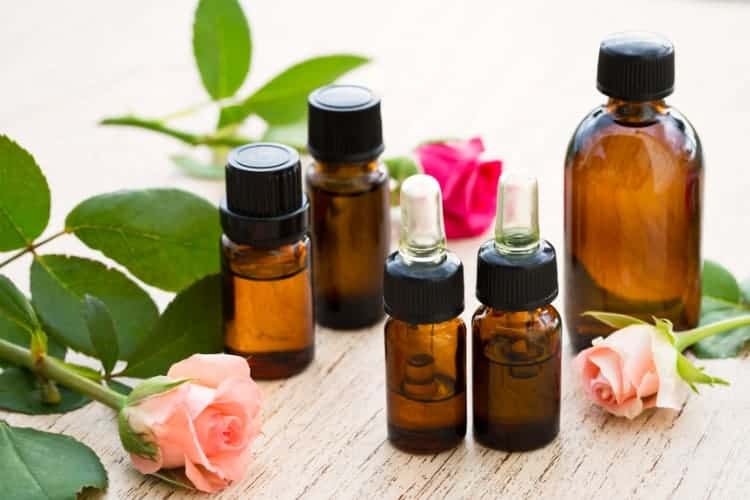
Can you mix essential oils together for face?
Depending on what you’re trying to achieve, you can blend different essential oils for your face. For example, you can blend tea tree and lavender oil for acne. On the other hand, for wrinkles, you can try a mix of clary sage and frankincense.
Can you dilute essential oils with water?
Essential oils cannot be diluted in water alone because they are mainly lipophilic, meaning that they dissolve in fats. The only way to mix essential oils and water is to use a dispersing agent, such as solubol, to help combine both ingredients.
Where do you rub essential oils?
You can apply essential oils from head to toe. For example, you can use them on your scalp to stimulate hair growth, on painful muscles or joints, or even on the back of the neck to relieve headaches.
CONCLUSION
Knowing how to dilute essential oils for skin use is critical for getting the best results from these potent natural compounds.
And as long as you follow the safety guidelines outlined throughout this article, you’re less likely to experience unwanted side effects from using them topically.
I hope this guide has answered your most burning questions on this topic. Now, go forth and dilute, and enjoy the beautiful results!
Additional references used for this article: 1, 2, 3, 4, 5, 6, 7, 8, 9, 10, 11, 12, 13, 14, 15, 16.
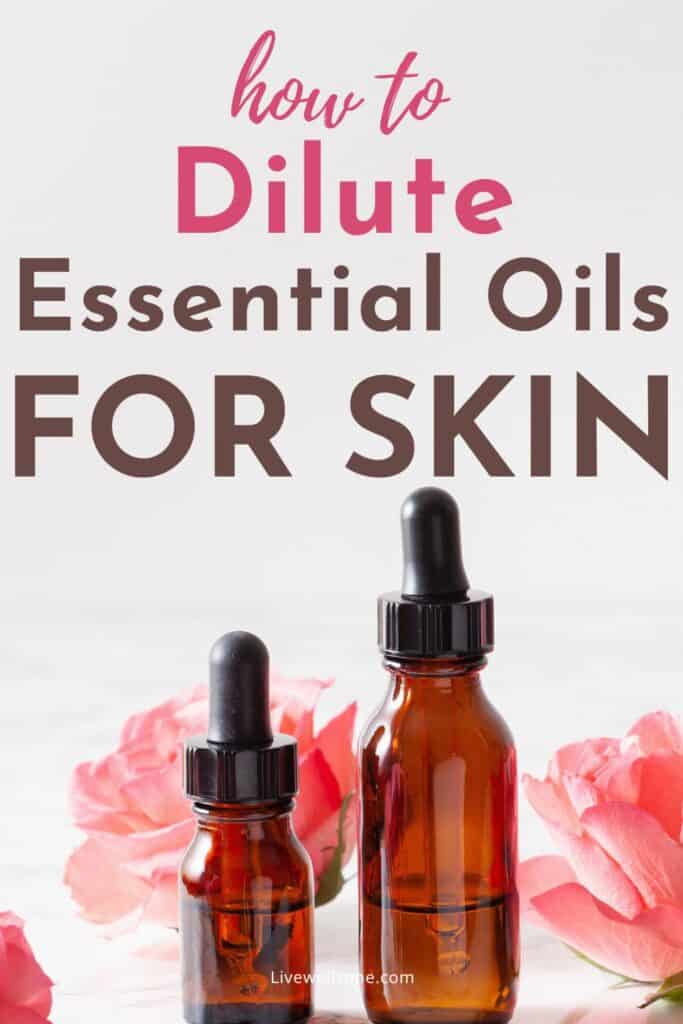
You Might Also Enjoy:
Non-Greasy Carrier Oils For Skin: 10 Oils To Fall In Love With
DIY Facial Oil Recipes for Glowing Skin: Acne-Prone, Oily, Dry, Sensitive, Combination & Aging Skin
How To Use Tea Tree Oil In Your Skin Care Routine (No More Blemishes!)
Tea Tree Oil vs Benzoyl Peroxide For Acne: Which Is Better and Can You Use Them Together?
What Kind Of Coconut Oil Is Best As A Carrier Oil for Skin? Fractionated vs Unrefined vs Refined
How to Mix Essential Oils for Hair Growth: A Step-by-Step Guide with Dilution Chart
Best Oils for Acne Prone Skin: Carrier, Essential and Cleansing Oils You Shouldn’t Ignore
11 Best Oils for Under Eyes (to Improve Wrinkles, Puffiness, Dark Circles and Dryness)
7 Carrier Oils That Have No Scent (great for skin, hair and other DIYs!)

